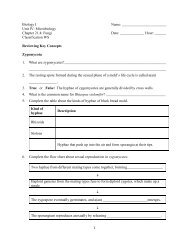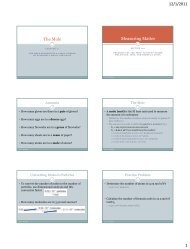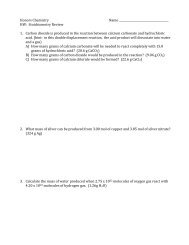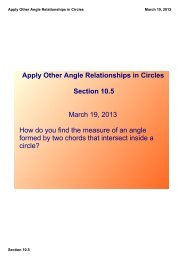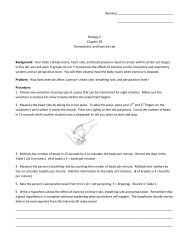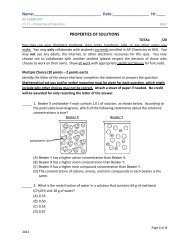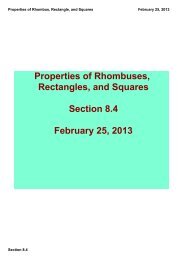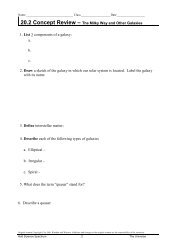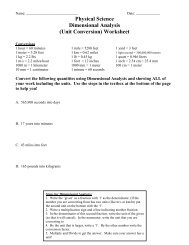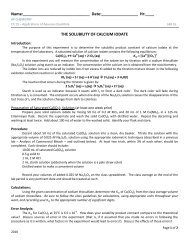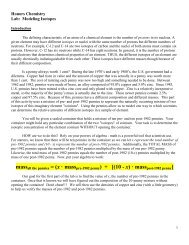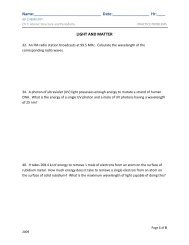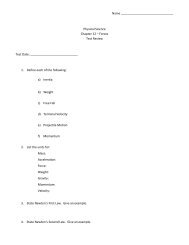Electrochemistry (Ch 17) - AP Chemistry
Electrochemistry (Ch 17) - AP Chemistry
Electrochemistry (Ch 17) - AP Chemistry
Create successful ePaper yourself
Turn your PDF publications into a flip-book with our unique Google optimized e-Paper software.
4/1/2011<br />
CELL POTENTIAL AND WORK<br />
• Suppose a certain galvanic cell has a maximum potential (at zero<br />
current) of 2.50 V<br />
– In a particular experiment, 1.33 moles of electrons were passed through this<br />
cell at an average actual potential of 2.10 V. The actual work done is: w = -qE<br />
• 1 mole of electrons has a charge of 96,485 C (called a “faraday”, F = 96,485 C/mol)<br />
– Actual work: w = -(1.33 mol)(96485 C/mol)(2.10 J/C) = -2.69 x 10 5 J<br />
– Maximum work: w max = - (1.33)(96485)(2.50) = -3.21 x 10 5 J<br />
– The efficiency of this cell is:<br />
WORK AND FREE ENERGY<br />
• Since<br />
w max = ∆G<br />
– For a galvanic cell,<br />
w max = -qE max = ∆G<br />
– Since q = nF<br />
– Then,<br />
∆G = -qE max = -nFE max<br />
– Or<br />
∆G = -nFE<br />
– For standard conditions: ∆G° = -nFE°<br />
<strong>Ch</strong> <strong>17</strong> - <strong>Electrochemistry</strong> 25<br />
<strong>Ch</strong> <strong>17</strong> - <strong>Electrochemistry</strong> 26<br />
∆G = -nFE°<br />
• This equation states that the maximum cell potential is directly<br />
related to the free energy difference between the reactants and the<br />
products in the cell.<br />
– Provides an experimental means to obtain ∆G (as you will do in LAB)<br />
– Confirms that a galvanic cell will run in the direction that gives a positive<br />
value for E cell (positive E cell corresponds to a negative ∆G )<br />
CALCULATING ∆G°<br />
• Using the Standard Reduction Potentials Table, calculate ∆G° for the<br />
reaction:<br />
• Is this reaction spontaneous<br />
Cu 2+ (aq) + Fe(s) Cu(s) + Fe 2+ (aq)<br />
– E cell = 0.78 V<br />
– ∆G = -1.5 x 10 5 J (SPONTANEOUS)<br />
<strong>Ch</strong> <strong>17</strong> - <strong>Electrochemistry</strong> 27<br />
<strong>Ch</strong> <strong>17</strong> - <strong>Electrochemistry</strong> 28<br />
PREDICTING SPONTANEITY<br />
• Using the Standard Reduction Potentials Table, predict whether 1 M<br />
HNO 3 will dissolve gold metal to form a 1 M Au 3+ solution.<br />
DEPENDENCE OF CELL POTENTIAL ON<br />
CONCENTRATION<br />
Section <strong>17</strong>.4<br />
– E° cell = -0.54 V (not spontaneous under standard conditions)<br />
– General rule: Oxidizing agents (reactants) higher on the list<br />
will oxidize reducing agents (products) lower on the list<br />
• Ex: H + will react with Fe but not Ag<br />
• The best REDUCING AGENT is Li, the best OXIDIZING AGENT is F 2<br />
<strong>Ch</strong> <strong>17</strong> - <strong>Electrochemistry</strong> 29<br />
<strong>Ch</strong> <strong>17</strong> - <strong>Electrochemistry</strong> 30<br />
5




